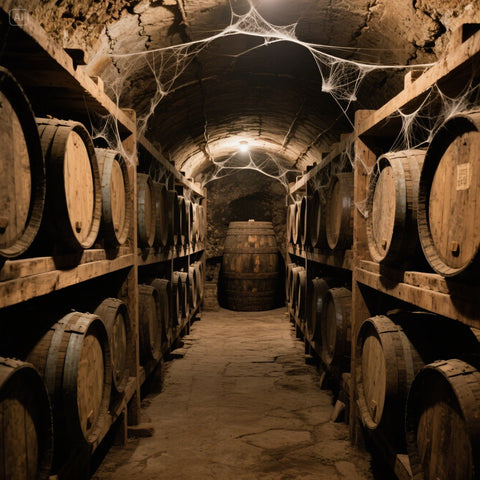The story of Syrah is one of ancient legends, modern science, and the relentless pursuit of truth in the world of wine. This noble grape variety, known for producing some of the world's most acclaimed red wines, has captivated viticulturalists and wine enthusiasts for centuries with its mysterious past and exceptional quality.
The Persian Legend
For generations, the romantic tale of Syrah's origins pointed to the ancient Persian city of Shiraz, modern-day Iran. According to this enduring legend, the grape was first cultivated in the gardens surrounding this historic city, known for its poetry, roses, and wine culture. The story suggests that Syrah made its way to Europe through trade routes, carried by merchants and crusaders who recognised its potential.
This Persian connection seemed plausible given the historical importance of Shiraz as a center of civilization and the fact that many of our cultivated grapes have Middle Eastern origins. The very name "Syrah" appeared to echo "Shiraz," reinforcing this narrative that captured the imagination of wine writers and historians for centuries.
The Hermitage Connection
Another compelling origin story emerged from France's Northern Rhône Valley, specifically around the legendary Hermitage hill. This tale speaks of a knight returning from the Crusades in the 13th century, carrying vine cuttings from far-off lands. Seeking solitude and redemption, he became a hermit on the steep slopes above the Rhône River, planting these precious vines that would eventually become the foundation of one of France's most revered wine regions.
The Hermitage story provided a romantic bridge between the exotic Persian origins and the undeniable excellence of Northern Rhône Syrah wines. It explained how this grape variety could have travelled from ancient Persia to establish itself so magnificently in the granite soils and continental climate of the Northern Rhône.
Scientific Revolution: DNA Analysis Changes Everything
The wine world's understanding of Syrah's origins underwent a dramatic transformation in the late 20th century with the advent of DNA analysis in viticulture. In 1998, groundbreaking research conducted by Dr. Carole Meredith at UC Davis revolutionised our knowledge of grape genetics and parentage.
Using sophisticated molecular techniques, researchers analyzed the genetic fingerprint of Syrah and compared it with hundreds of other grape varieties. The results were startling and definitively debunked centuries of accepted wisdom about the grape's exotic origins.
The True Parents Revealed
The DNA analysis revealed that Syrah is actually the offspring of two relatively obscure French grape varieties: Dureza and Mondeuse Blanche. This discovery placed Syrah's true origins firmly in France, specifically in the southeastern regions where these parent varieties were known to grow.
Dureza, a red grape variety, contributed the paternal genetics to Syrah. This rare variety was historically grown in the Ardèche region of southeastern France but had nearly disappeared from cultivation. Mondeuse Blanche, the maternal parent, is a white grape variety from the Savoie region in the French Alps. The natural cross-pollination between these two varieties, likely occurring centuries ago, gave birth to the grape we now know as Syrah.
Implications of the Discovery
This scientific breakthrough had profound implications for understanding not just Syrah's origins but the broader history of European viticulture. It demonstrated that many of our most celebrated grape varieties might have more prosaic, local origins than the exotic tales that surrounded them.
The discovery also highlighted the remarkable genetic diversity that existed in France's historical vineyards. The fact that two relatively minor grape varieties could combine to create one of the world's most important wine grapes speaks to the complex evolutionary processes that shaped European viticulture over millennia.
Regional Development and Spread
With its true French origins established, researchers could better understand how Syrah spread throughout the wine world. From its likely birthplace in southeastern France, the grape gradually established itself in the Northern Rhône Valley, where the unique terroir of steep granite slopes and continental climate allowed it to express its full potential.
The Northern Rhône became Syrah's spiritual home, producing wines of extraordinary depth, complexity, and aging potential. Appellations like Hermitage, Côte-Rôtie, Cornas, and Saint-Joseph became synonymous with Syrah excellence, each expressing different facets of the grape's personality through their distinct microclimates and soil compositions.
Global Journey
From France, Syrah eventually travelled to other wine regions around the world. In Australia, where it's known as Shiraz, the grape found a second home and developed its own distinct style. Australian Shiraz tends to be more fruit-forward and powerful than its French counterparts, reflecting the warmer climate and different winemaking philosophies.
The grape has also found success in other New World regions, including California's Central Coast, Washington State, South Africa's Western Cape, and various regions in South America. Each location brings out different characteristics in Syrah, demonstrating the grape's remarkable adaptability while maintaining its essential character.
The Australian Shiraz Revolution
Australia's relationship with Shiraz began in the 1830s when James Busby, often called the father of Australian viticulture, brought vine cuttings from Europe to establish the country's wine industry. Among these precious imports was Syrah, which would eventually become Australia's signature red grape variety under its local name, Shiraz.
The choice to call the grape "Shiraz" rather than "Syrah" in Australia reflects the historical belief in its Persian origins. Australian winemakers embraced this exotic connection, and the name stuck even after DNA analysis revealed the grape's true French parentage. Today, Australian Shiraz represents a distinct style that has earned global recognition and respect.
McLaren Vale: The Heart of Australian Shiraz
No discussion of Australian Shiraz would be complete without examining McLaren Vale, the region that many consider the spiritual home of Australian Shiraz. Located just south of Adelaide in South Australia, McLaren Vale has been producing exceptional Shiraz for over 170 years, creating wines that perfectly embody the Australian interpretation of this noble grape.
The story of McLaren Vale Shiraz begins in 1838 when John Reynell planted the first vines in the region, establishing Reynella winery. However, it was the vision of Thomas Hardy and other pioneering winemakers that truly established McLaren Vale as a Shiraz powerhouse. These early settlers recognized that the region's unique combination of Mediterranean climate, diverse soils, and proximity to the sea created ideal conditions for Shiraz cultivation.
The Terroir of McLaren Vale
McLaren Vale's success with Shiraz stems from its distinctive terroir. The region enjoys a Mediterranean climate with warm, dry summers and mild, wet winters. The proximity to Gulf St Vincent provides cooling sea breezes that moderate temperatures during the crucial ripening period, helping to maintain acidity while allowing full flavour development.
The soils of McLaren Vale are remarkably diverse, ranging from red clay over limestone to sandy loams and ancient geological formations. This diversity allows winemakers to craft Shiraz wines with varying characteristics, from elegant and structured to rich and powerful. The famous red ironstone soils, known locally as "biscay," are particularly prized for producing Shiraz with intense color, robust tannins, and exceptional aging potential.
Evolution of McLaren Vale Shiraz Style
Over the decades, McLaren Vale Shiraz has evolved from rustic, robust wines to sophisticated expressions that rival the world's best. The 1960s and 1970s saw the emergence of premium producers like d'Arenberg, Wirra Wirra, and Coriole, who began to focus on quality over quantity and developed the distinctive McLaren Vale style.
McLaren Vale Shiraz is characterized by its full-bodied nature, rich dark fruit flavors, and distinctive chocolate and spice notes. The wines often display a unique combination of power and elegance, with velvety tannins and excellent aging potential. The region's winemakers have mastered the art of balancing ripeness with freshness, creating wines that are both immediately appealing and capable of developing complexity over decades.
The Sustainable Revolution
In recent years, McLaren Vale has become a leader in sustainable viticulture, with many producers embracing organic and biodynamic farming practices. The McLaren Vale Sustainable Winegrowing Program, launched in 2019, aims to make the region carbon neutral by 2030. This commitment to sustainability reflects a deeper understanding of the relationship between healthy soils, balanced ecosystems, and exceptional wine quality.
These sustainable practices have enhanced the expression of McLaren Vale terroir in Shiraz wines, with many producers reporting improved fruit quality and more authentic expressions of their vineyard sites. The movement toward sustainability has also attracted a new generation of winemakers who combine traditional techniques with innovative approaches to create exciting new expressions of McLaren Vale Shiraz.
Modern Understanding
Today's understanding of Syrah combines scientific rigor with appreciation for the grape's remarkable journey through history. While the romantic tales of Persian origins and crusading knights have been disproven, the true story of Syrah's emergence from the natural crossing of two French varieties is no less fascinating.
This scientific approach to understanding grape origins has opened new avenues for viticultural research and wine improvement. By understanding the genetic relationships between varieties, researchers can better predict how grapes might adapt to new climates and conditions, information that becomes increasingly valuable as wine regions face the challenges of climate change.
Legacy and Recognition
Today, McLaren Vale is home to over 80 wineries and some of Australia's most celebrated Shiraz producers. Names like Clarendon Hills, Kangarilla Road, and Shingleback have joined the established giants in creating world-class Shiraz that commands international respect. The region's wines regularly receive high scores from international critics and compete successfully on the global stage.
The success of McLaren Vale Shiraz has also contributed to the broader recognition of Australian wine quality. Many international wine enthusiasts first discovered Australian wine through McLaren Vale Shiraz, leading to greater appreciation for the country's diverse wine regions and styles.
Other New World Expressions
Beyond Australia, Syrah has found success in other New World regions, including California's Central Coast, Washington State, South Africa's Western Cape, and various regions in South America. Each location brings out different characteristics in Syrah, demonstrating the grape's remarkable adaptability while maintaining its essential character.
Conclusion
The story of Syrah's origins serves as a perfect example of how modern science can illuminate and sometimes overturn long-held beliefs about wine and viticulture. While we may have lost some romantic legends along the way, we have gained a deeper, more accurate understanding of how one of the world's great grape varieties came to be.
The discovery that Syrah emerged from the genetic combination of two humble French varieties rather than exotic Persian gardens doesn't diminish its nobility or the extraordinary wines it produces. Instead, it adds a new chapter to the ongoing story of human cultivation and the remarkable diversity of the vine, reminding us that truth in wine, as in life, is often more complex and interesting than the myths we create to explain it.
From the steep slopes of Hermitage to the red soils of McLaren Vale, Syrah continues to evolve and adapt, carrying within its genetic code the story of its humble French origins while expressing the unique character of each place it calls home. The Australian chapter of this story, particularly the remarkable success in McLaren Vale, demonstrates how a grape variety can truly make itself at home in a new terroir, creating wines that are both distinctly local and unmistakably part of the greater Syrah family.




Comments (0)
There are no comments for this article. Be the first one to leave a message!